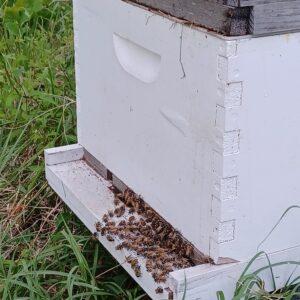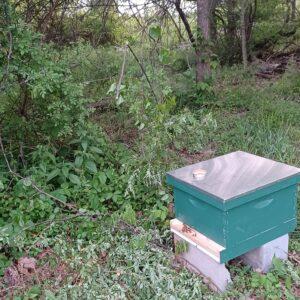One of the reasons that I love homesteading so much is that every day has the potential for a new experience. This morning, I set out to get my plants ready for market. Instead, we ended up welcoming a new hive of honeybees into our apiary!
While I was finishing up my morning chores, I heard a loud buzzing sound coming from our apiary. If a queen bee is weak and the worker bees’ attempts to make a stronger queen out of larvae fail, the bees may swarm and leave the hive in a large, buzzing cloud. Concerned, I walked over to see what was happening.
Spilling out of a very strong, established hive was a lot of honeybees. Normally, the hive entrance will be active with workers flying in and out of the hive, or even drones hanging out protecting the hive.

Usual Bee Activity
These bees were literally flying out of the hive entrance and piling up on the ground right in front of the hive. Above, bees were wildly flying, circling, loosely, but staying together. They were staying fairly nearby, but moved toward a group of young trees that help provide protection from the winter winds.
I ran into my workshop and grabbed my smoker. Smoke helps to calm bees. Beekeepers often have an active smoker while working in hives, sending plumes of smoke toward the bees, the hives, and even the beesuits they are wearing. After I got it going, I returned to the apiary and smoked the area in an attempt to calm the upheavel.

Smoker
As the day progressed, we realized that this was a new hive that had swarmed from another location. Their drones were scouting out potential places to relocate, and came across our bees – who have access to water, protection from the elements from trees and hills, plenty of pollen to collect, and ample provision of bee feed. These drones had attempted to move into our hive, kill the queen, and take their honey – but they were ejected.
We bought a new hive box with 10 frames at EverGro in Orange, Virginia, painted it, and dotted the entrance and frames with lemon juice to attract the bees. In the meantime, the ejected bees had formed a protective barrier around their queen in a young tree about 15′ away from the hive they failed to overtake.
After suiting up, we smoked the loose bees and took handfuls of bees and placed them into the hive. We then cut section by section of branches where the bees stubbornly stayed until we finally got the branch with the queen bee on it. And her court (her closest protectors) and her hive followed!

Settled Transplant Bees
So far, the new hive of transplanted bees is settling in just fine, busily going over the hill to collect water and food – and staying far away from the territory of hive they failed to overwhelm.

